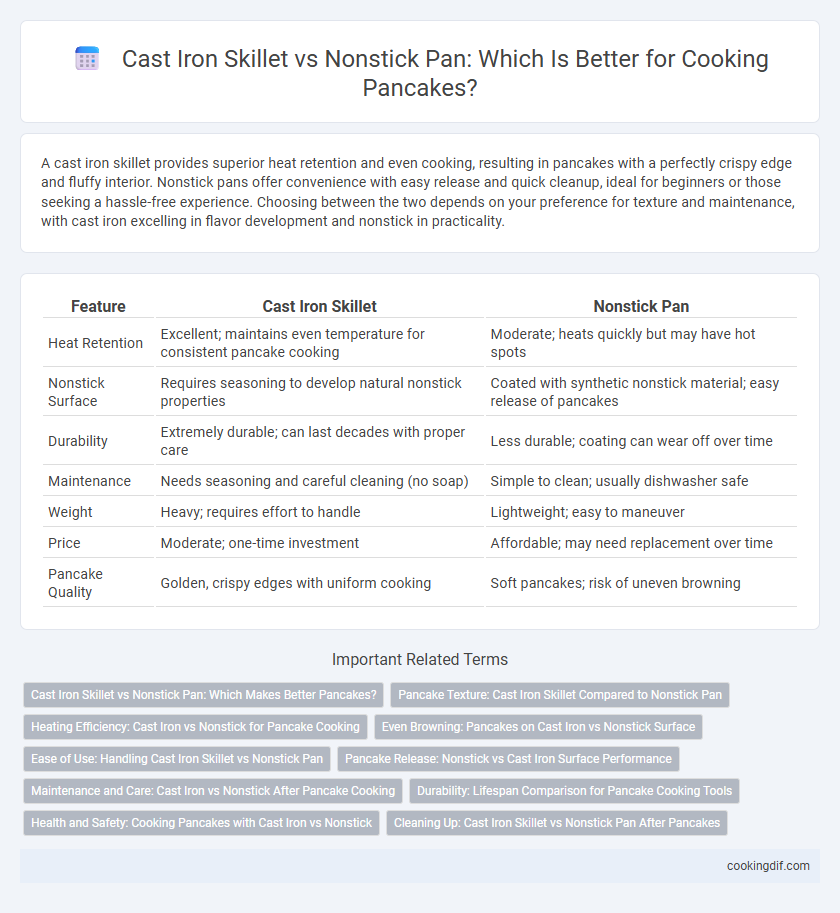A cast iron skillet provides superior heat retention and even cooking, resulting in pancakes with a perfectly crispy edge and fluffy interior. Nonstick pans offer convenience with easy release and quick cleanup, ideal for beginners or those seeking a hassle-free experience. Choosing between the two depends on your preference for texture and maintenance, with cast iron excelling in flavor development and nonstick in practicality.
Table of Comparison
| Feature | Cast Iron Skillet | Nonstick Pan |
|---|---|---|
| Heat Retention | Excellent; maintains even temperature for consistent pancake cooking | Moderate; heats quickly but may have hot spots |
| Nonstick Surface | Requires seasoning to develop natural nonstick properties | Coated with synthetic nonstick material; easy release of pancakes |
| Durability | Extremely durable; can last decades with proper care | Less durable; coating can wear off over time |
| Maintenance | Needs seasoning and careful cleaning (no soap) | Simple to clean; usually dishwasher safe |
| Weight | Heavy; requires effort to handle | Lightweight; easy to maneuver |
| Price | Moderate; one-time investment | Affordable; may need replacement over time |
| Pancake Quality | Golden, crispy edges with uniform cooking | Soft pancakes; risk of uneven browning |
Cast Iron Skillet vs Nonstick Pan: Which Makes Better Pancakes?
Cast iron skillets provide superior heat retention and even cooking, essential for achieving the perfect golden-brown crust on pancakes, whereas nonstick pans offer easy release and require less oil or butter. The natural seasoning of cast iron can enhance flavor and create a crispier texture, while nonstick surfaces simplify cleanup and reduce the risk of sticking. For those seeking durability and depth of flavor, cast iron is preferable, but nonstick pans offer convenience and consistency for quick pancake preparation.
Pancake Texture: Cast Iron Skillet Compared to Nonstick Pan
A cast iron skillet creates pancakes with a crispier, golden-brown edge due to its superior heat retention and even distribution, which enhances Maillard reactions for richer texture and flavor. Nonstick pans produce softer pancakes with more uniform cooking but less crispness, as their lower heat tolerance limits browning. For pancake enthusiasts seeking a balance of crispy exterior and tender interior, cast iron skillets offer distinct texture advantages over nonstick alternatives.
Heating Efficiency: Cast Iron vs Nonstick for Pancake Cooking
Cast iron skillets offer superior heat retention and even heating, which ensures pancakes cook evenly with a consistent golden-brown crust. Nonstick pans heat up faster but often have uneven heat distribution, leading to potential hotspots and less uniform pancake texture. The thermal mass of cast iron allows for steady cooking temperatures, making it ideal for perfect pancakes.
Even Browning: Pancakes on Cast Iron vs Nonstick Surface
Cast iron skillets provide superior even browning for pancakes due to their excellent heat retention and distribution properties, which create a consistent cooking surface. Nonstick pans offer convenience and easy release but often have uneven heat spots that can cause patchy browning. For achieving perfectly golden, evenly cooked pancakes, cast iron skillets are preferred by many chefs and home cooks.
Ease of Use: Handling Cast Iron Skillet vs Nonstick Pan
Cast iron skillets require preheating and seasoning to ensure even heat distribution and prevent sticking, which can demand more maintenance and skill compared to nonstick pans. Nonstick pans offer superior ease of use with faster heating times and effortless pancake flipping due to their smooth, coated surfaces. Ergonomically designed handles on many nonstick pans provide better grip and lighter weight, enhancing maneuverability during cooking.
Pancake Release: Nonstick vs Cast Iron Surface Performance
Nonstick pans provide superior pancake release due to their smooth, synthetic surface that minimizes sticking and enables easy flipping. Cast iron skillets improve with seasoning, forming a natural nonstick layer that enhances pancake release over time but may require more maintenance and optimal temperature control. For immediate, consistent pancake release, nonstick surfaces excel, while cast iron offers durability and flavor enhancement with gradual seasoning development.
Maintenance and Care: Cast Iron vs Nonstick After Pancake Cooking
Cast iron skillets require thorough cleaning without soap to maintain their seasoning, and regular oiling prevents rust, ensuring a natural nonstick surface over time. Nonstick pans need gentle cleaning with non-abrasive sponges and should avoid high heat to preserve their coating integrity and prolong lifespan. Proper maintenance of cast iron enhances durability, while careful care of nonstick pans prevents peeling and maintains optimal pancake cooking performance.
Durability: Lifespan Comparison for Pancake Cooking Tools
Cast iron skillets offer exceptional durability with proper seasoning and maintenance, often lasting several decades, making them ideal for consistent pancake cooking. Nonstick pans, while convenient for easy batter release, typically have a shorter lifespan of 3-5 years due to coating degradation from high heat and metal utensils. The investment in a cast iron skillet ensures long-term performance and resilience, whereas nonstick pans may require more frequent replacement.
Health and Safety: Cooking Pancakes with Cast Iron vs Nonstick
Cooking pancakes with a cast iron skillet offers the benefit of avoiding harmful chemical coatings found in some nonstick pans, making it a safer option for health-conscious individuals. Cast iron skillets develop a natural, non-toxic seasoning over time, which enhances pancake flavor without releasing toxic fumes at high temperatures. Nonstick pans, while convenient, may degrade with scratches or overheating, potentially releasing chemicals that pose health risks during cooking.
Cleaning Up: Cast Iron Skillet vs Nonstick Pan After Pancakes
Cleaning a cast iron skillet after cooking pancakes requires careful hand washing with minimal soap to preserve seasoning and prevent rust, followed by thorough drying and occasional oiling. Nonstick pans offer easier cleanup due to their smooth surface, which resists sticking and typically only needs gentle wiping or rinsing. While cast iron demands more maintenance, it delivers durability and improved heat retention, whereas nonstick pans prioritize convenience in daily pancake preparation.
Cast iron skillet vs nonstick pan for pancake cooking Infographic

 cookingdif.com
cookingdif.com